Home / Past Newsletters / September 2014
September 2014
In this issue:
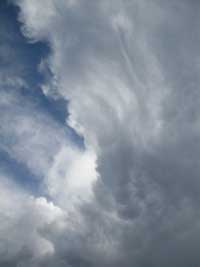
- New: Peel-off face masks, lip balm tubes and trays, Epsom salts, rosebuds
- Smaller quantities for many oils and essential oils
- Orris root and NZ organic olive oil back in stock
- Kawakawa: Wonderful NZ products
- Substitution: Trilogy Eye Contour cream
- New recipe: Kawakawa and shea lemon hand cream
- Pink Ribbon: Make some soaps, create your own mini-event
- Enter the draw for Go Native Eye Contour Cream
- What does it mean? An update on 'virgin' in NZ
- Photos: Blossom time
New stock
 Peel-off face masks: When you are in need of a few minutes' break from a stressed life, one of these do-it-yourself face masks is perfect. We've been looking for some time for a ready-to-use mask with natural ingredients, and we're delighted with these. Choose from Gold and Pearl (pictured - containing pearl powder), Luminous Rice (with whitening powder), and Teatree (for troubled skin). And we've found that one pack can do two applications!
Peel-off face masks: When you are in need of a few minutes' break from a stressed life, one of these do-it-yourself face masks is perfect. We've been looking for some time for a ready-to-use mask with natural ingredients, and we're delighted with these. Choose from Gold and Pearl (pictured - containing pearl powder), Luminous Rice (with whitening powder), and Teatree (for troubled skin). And we've found that one pack can do two applications!
- Lip balm tubes: You have been asking for ages, and now we have them: white plastic lip balm tubes, and also filling trays for those of you making products to sell. The trays are great for trouble-free filling!
- Epsom salts have been working their magic for a long, long time. There's nothing like a hot bath with Epsom salts for soothing tired muscles - and in my experience, preventing stiffness the next day! Read here for lots more ideas for using Epsom salts.
- Exquisite tiny rosebuds make a beautiful decoration for gift soaps and in packed bath bombs or other goodies.
Smaller quantities of many oils
In response to your requests, we now have smaller quantities of many oils and essential oils, and we have a new 30ml sample bottle on order - arriving end of October - which will mean the end of the half-full 60ml bottles.
Orris root is back in stock - it has taken a while to find a new supplier, but for all you potpourri makers, we have some at last.
NZ organic olive oil: Crushed from this season's crop and just arrived, this beautiful oil is grown biodynamically. Biodynamics is possibly the most life-affirming of the organic certifications, a system that enhances biodiversity (from soil microbes upwards) and actually creates topsoil!
Pure kawakawa products
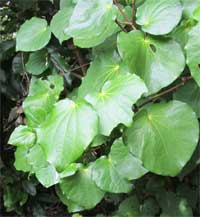
New Zealand’s native plants provide a wonderful array of healing compounds. One of the most versatile is the beautifully scented kawakawa, which contains volatile oils, alkaloids, lignans and flavonoids.
Kawakawa has beautiful shiny heart-shaped leaves that are often are full of holes – they are a favourite food of a native caterpillar. The caterpillars’ actions enhance the medicinal value of the leaves, as the plant releases higher concentrations of its active compounds as a defence against being chewed into oblivion!
Kawakawa products have anti-inflammatory and antimicrobial properties, and have traditionally been used for bruising, chilblains, cuts and abrasions, among other things. Kawakawa can be an effective treatment for eczema.
 Kawakawa (Macropiper excelsum) is related to the plants that produce kava and edible pepper, and some other members of the Piper family have been used in traditional societies for their healing and cleansing properties.
Kawakawa (Macropiper excelsum) is related to the plants that produce kava and edible pepper, and some other members of the Piper family have been used in traditional societies for their healing and cleansing properties.We have a great range of kawakawa products. The infused oil, hydrosol, and hydroethanolic extract are made with great care by a New Zealand medical herbalist.
Kawakawa infused oil is great for using in moisturisers and skin creams. Try making our Basic Moisturiser with kawakawa infused oil replacing almond oil – soothing for eczema and all kinds of stressed and irritated skin.
Traditionally kawakawa has been used as an insect repellant. Try smoothing the infused oil on skin as a pleasant alternative to chemical deterrents.
Kawakawa hydrosol has many applications.
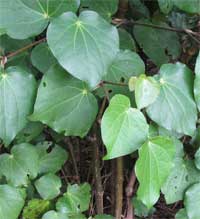
- Facial toner: Gentle and refreshing as a toner.
- Following waxing and hair removal: Soothes skin and reduces the likelihood of inflammation.
- A wash for cuts and scrapes: If you have children who love playing outside, there are inevitable cuts and scrapes. Kawakawa hydrosol is ideal for gentle cleaning.
- Baby care: Its gentle antibacterial action and delicate aroma makes it a wonderful baby wipe spray (use a mister on a 60ml bottle).
- A deodorant: I use kawakawa hydrosol as a delightful deodorant spray, again using a mister on a 60ml bottle.
- A relaxing room spray: Kawakawa’s unique scent will gently perfume a room – and more! Kawakawa is an adaptogen, with a toning, strengthening and restorative action which enhances the body’s ability to adapt to physical and emotional stress.
Kawakawa hydroethanolic extract is made from fresh kawakawa extract in ethanol and spring water. Add it to a cream and use it to help relieve:
- painful muscles and joints
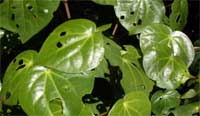
- gardening rashes
- bites and stings
- nappy rash
- grazes
- bruising
Pink Ribbon
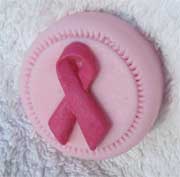
The New Zealand Breast Cancer Foundation will be holding its annual street appeal on October 10 and 11. If you sell Melt & Pour soaps at markets, you may be interested in our Pink Ribbon soap mould.
And if you'd like to raise some money for NZBCF, follow this link:
http://www.nzbcf.org.nz/GETINVOLVED/HoldanEvent.aspx
Substitution:
Trilogy Eye Contour Cream
Creating your own version of favourite products is fun, though it can require a bit of experimentation to get the proportions just right!
For creating a substitution for a cream, there are two main principles:
- Ingredient listings show all ingredients in order, with the main ingredient at the top of the list down to the one that makes up the smallest part at the bottom.
- The building blocks of a cream are oil, water, and emulsifier, typically in a ratio of about 3:5:1, although this varies. Other ingredients are added for their special qualities.
This top-of-the-line cream is designed to smooth and firm the delicate skin around the eyes.
I (Elinor) will go through the ingredients, explaining what their purpose is, before working out how to create a substitution.
First, here is the ingredients’ listing.
If the use isn’t obvious, there's an explanation in brackets.
Alternative ingredients are also in brackets.
Almond oil
Evening primrose oil
Jojoba oil
*Glyceryl stearate (emulsifier)
*Stearic acid (emulsifier)
*Cetearyl alcohol (emulsifier)
Rosehip oil
Tomato oil and capric/caprylic triglyceride and cranberry oil and sunflower oil and vitamin E
(This is a bunch of oils. I’m going to use sunflower oil.)
Lycopene (A bright red carotene pigment found in fruit and vegetables; we could use beta carotene but it would make the cream very yellow. I’m going to leave it out.)
Acai oil and vitamin E (I’ll use kiwi seed oil.)
Oat kernel extract (I’ll use hydrolysed wheat protein.)
Shea butter
Aloe vera extract
Avocado oil
Eyebright extract (I’ll use chamomile extract.)
Vitamin E and acetic acid (aids preservation)
Carrot seed oil
*Sodium stearoyl glutamate (emulsifier)
Citric acid (neutraliser)
Dehydroacetic acid and benzyl alcohol (preservative; Geogard 221)
*These are all emulsifiers. Go Native will use emulsifier O.
Go Native Eye Contour Cream
(makes 200g)
Water Phase:
90g water
20g glycerin
5g hydrolysed wheat protein
pinch of aloe vera powder and pinch of chamomile extract powder dissolved in the water above
Oil Phase:
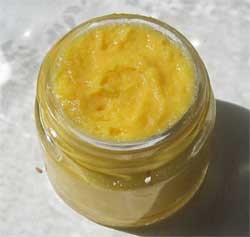
24g emulsifier O
15g almond oil
10g evening primrose oil
10g jojoba oil
10g rosehip oil
6g sunflower oil
5g kiwi seed oil
5g shea butter
5g avocado oil
Last Phase:
1g carrot infused oil
1g Geogard 221
Method:
- Heat Water Phase to 65°C.
- Heat Oil Phase separately until melted. Cool to 65°C.
- Pour Oil Phase into Water Phase and blend with a stick blender until thick.
- Add Last Phase and blend again.
- Spoon into pots.
The carrot oil makes the cream yellow. If you use organic virgin rosehip oil, it will be even more yellow, so it’s probably better to use refined rosehip oil.
I have left the cream unfragranced as many essential oils make my eyes water if they are too close to my eyes.
New Recipe:
Kawakawa and shea lemon hand cream
Makes 150g
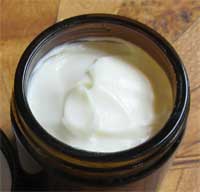
Water Phase:
100g water
1g aloe powder
4g glycerin
Oil Phase:
20g kawakawa infused oil
10g shea butter
10g conditioner pellets
Last Phase:
1g Geogard 221
1g lemon essential oil
Method:
- Heat the Water Phase and Oil Phase separately in 2 pots until both are 65°C. (Heat the oil phase until the conditioner pellets melt, then cool to 65°C.)
- Combine the two phases and beat with a stick blender. Use the blender beaker if you have one, to prevent spattering.
- When it is beginning to thicken, add Last Phase and blend.
- Spoon into a container.
What does it mean?
Virgin oils
In the last newsletter we talked about what the term Extra Virgin means. I’m delighted to tell you that New Zealand has an olive oil certifying body which follows the standards of the International Olive Council. Learn more at
http://www.olivesnz.org.nz/certification-the-olive-mark/
Photo gallery - the first blossom
The prunus family provides several of our most loved oils - almond, peach kernel, apricot kernel.
The fruit trees are starting to flower, battling wind and rain here in Auckland. Hopefully the bees have been able to get out and about between the downpours to do their fertilising work, ensuring a good crop in the summer.
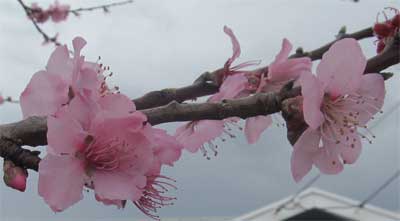
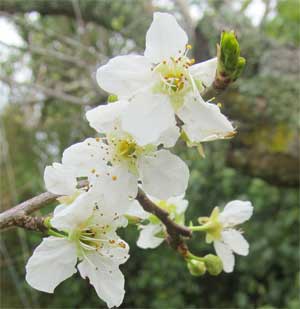 |
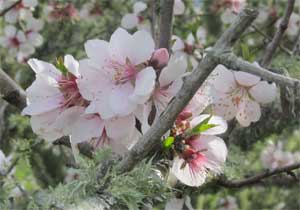 |
Kind regards
Elinor, Chelsea, & Jacqui
